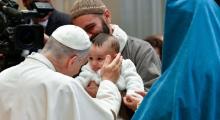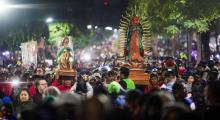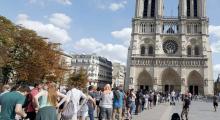Issued by the Catholic Center for Studies and Media - Jordan. Editor-in-chief Fr. Rif'at Bader - موقع أبونا abouna.org

Pope has a big agenda in Asia
When Pope Francis embarks on the 32nd trip of his pontificate Tuesday, November 29, headed towards Thailand and Japan, he will once again be visiting nations where Catholics are a small minority. In both countries, there’s one Catholic for every 200 people, as opposed to roughly one for five in the United States.
The November 19-26 trip will be Francis’s fourth to Asia, following South Korea (2014), Sri Lanka and the Philippines (2015), and Bangladesh and Myanmar (2017).
Though his first priority will be to boost the small local Catholic communities, Pope Francis is bound to focus most of his 18 scheduled speeches, all in Spanish, on issues close to his heart and which heavily affect these countries.
The wide range of topics likely will include human trafficking and the exploitation of women and children in Thailand’s sexual tourism industry; the death penalty; corruption; and the high number of suicides among young people.
He’s also expected to call for peace and nuclear disarmament, especially during stops in Hiroshima and Nagasaki in Japan, and care for the environment.
Just to put some of these priorities into context:
o Sexual tourism: Both girls and boys as young as ten years old are forced into prostitution in Thailand, either by local pedophiles or foreign sex tourists. Often they’re forced to service five to ten clients a day, constituting what Francis condemns as “modern day slavery,” and a “crime against humanity.” UNICEF describes child prostitution as “one of the gravest infringements of rights that children can endure.”
o The death penalty: The Pontiff recently changed the official compendium of Catholic teaching to reflect that capital punishment is never admissible. However, it’s still allowed in Japan. The local Church has invited Iwao Hakamada, an 86-year old man who spent 48 years on death row, to meet Francis. This former boxer, Catholic convert, was released in 2014 when DNA analysis proved the evidence against him could have been planted.
o Suicide: According to a 2018 government report, 250 elementary and high school age children in Japan took their own lives between 2016 and 2017 for a variety of reasons including bullying, family issues and stress. It’s the top cause of death for people between the ages of 15 and 39, and Japan’s suicide rate is the sixth highest in the world.
o Peace: While in Hiroshima and Nagasaki, the world’s only two cities to have experienced nuclear weapons, Pope Francis is expected to reiterate his calls for nuclear disarmament. Though post-war Japan has a history of pacificism, Prime Minister Shinzo Abe is currently attempting to revise the constitution to allow for rearmament. (The Nippon Carta Magna, article nine, states that the Japanese people forever renounce war as a sovereign right, aspiring “to an international peace based on justice and order.”)
According to the Vatican’s spokesman Matteo Bruni, there will also be a focus on interreligious dialogue, particularly with Buddhism in Thailand, where Pope Francis will visit the Wat Ratchabophit Sathit Maha Simaram Temple and meet Supreme Patriarch Somdet Phra Ariyavongsagatanana IX. Pope Francis will also meet with King Vajiralongkorn and Prime Minister General Prayut Chan-o-cha.
Bruni also said that in Thailand, Pope Francis will have the help of Salesian Sister Ana Rosa Sivori, the pope’s second cousin who has been a missionary in the country for more than 50 years. The pope himself proposed Sivori to serve as his translator.
Italian Father Bruno Rossi, a missionary in Thailand for the past 20 years, said Pope Francis’ trip is one for which the country has been waiting for over 35 years, since the last time a pope, St. John Paul II, visited the kingdom once known as Siam.
He believes that with Thailand being a “pyramidal society,” the Pope’s visit can help with interreligious dialogue at the grassroots level: “After people see the leaders meet and dialogue, it’s easier for us to do the same,” he told Crux over the phone.
Thai society, he said, is one in which those in leadership are in the spotlight and the rest of society “in the shadows.” Christianity, with Christ “bending on his knees to wash the feet of the apostles, is hard for most to comprehend.”
“The fact that the Pope is visiting the king and monks is within their criteria, superior to superior,” Rossi argued, which will “break the ice,” so the trip will be a “very positive experience” for the local Church.
However, Rossi said Catholics in Thailand are not exempt from pyramidal psychology, with “the Church in Bangkok is very different to the one on the peripheries,” so he hopes that “inspired by the Holy Spirit, Francis will have some words to help us remember that we are called to walk together, to bring Christ to as many people as possible.”
If the Pope were to issue such a reminder, it would probably come on Friday, November 21, when he goes to St. Peter’s parish in Samphran, 20 miles from Bangkok, to meet priests, religious men and women, catechists and seminarians. It could also come later in the day when he addresses the country’s bishops at the nearby shrine of Blessed Nichlas Bunkerd Kitbamrung, the country’s first priest martyr.
Joining the bishops will be the executive officers of the Federation of Asian Bishops’ Conferences, including Cardinal Charles Maung Bo of Yangon, Myanmar, who welcomed the Pope last year, and Cardinal Malcolm Ranjith of Colombo, Sri Lanka, who welcomed Francis in 2015.
“This is a moment of grace to the Christians and others in these countries,” Bo said in a message. “Pope Francis is a prophet of modern times, proclaiming Christ’s kingdom of peace to everyone. He is a world leader who has proclaimed not only a religious message but a message to humanity.”
Speaking with Crux, Rossi said that when he first arrived, it was very hard for him to include the washing of the feet during the Mass of the Last Supper on Holy Thursday, because people couldn’t accept that a priest would kneel down in front of them and “wash the dirtiest part of their bodies.” Things have progressed since then, he said, with local TV stations showing footage of Francis doing just that as a way of understanding who he is and what he represents.
“He’s coming to dialogue, to understand the Thai people, and to bring a sense of fraternity among religions,” Rossi said.
Rev. Heng Sure, a Buddhist monk who lives in Berkeley, California, and who’s actively engaged in interreligious dialogue, sees an alignment between Buddhism and the message of Pope Francis. He told Crux that “the purpose of cultivation, of practising the spiritual path, is to wake up so that you can help others wake up.”
“It’s very reminiscent of the sense of what I get from the Holy Father. His whole life is about bringing the message of Jesus to people who are suffering, who are in pain, and we completely resonate with that sense of Catholicism as a positive social force,” he said.
There are only around 389,000 Thai Catholics, representing less than one percent of the population. Nevertheless, 50,000 to 60,000 of them are expected to attend a Mass Francis will celebrate in the National Stadium in Bangkok.
Japan is a country that has long been in Francis’ heart. As a young Jesuit, Jorge Mario Bergoglio dreamed of becoming a missionary in the land of the cherry blossoms. Several decades later, his first-ever visit will include a stop at a monument in honor of 26 Jesuit martyrs executed in 1597, at the early stages of two centuries of Christian persecution.
While in Japan, he’ll also encounter Buddhist and Shintoist leaders during a summit at the Memorial for Peace in Hiroshima on November 24.
Many hope the visit to Japan will revitalize the Church in a country where the number of Catholics continues to drop, as does the general population, with an estimated one-quarter of the Japanese being 65 and older. In 2006, over 7,000 people were baptized, while last year, only 518 people were welcomed into the Church.
Monday, November 25, will see Francis encountering 10 victims of the so-called “triple disaster” of Fukushima, which left close to 18,000 dead in 2011 due to an earthquake, a tsunami and a nuclear meltdown. Later in the day he’ll meet Japan’s youth and later still, before encountering national authorities, he’ll celebrate his second Mass on this soil, this time in Tokyo’s Dome.
During the almost 14-hour long flight from Tokyo to Rome at the end of the trip, the Argentine pontiff is expected to give one of his famous in-flight press conferences, answering questions from journalists traveling on the papal plane.







